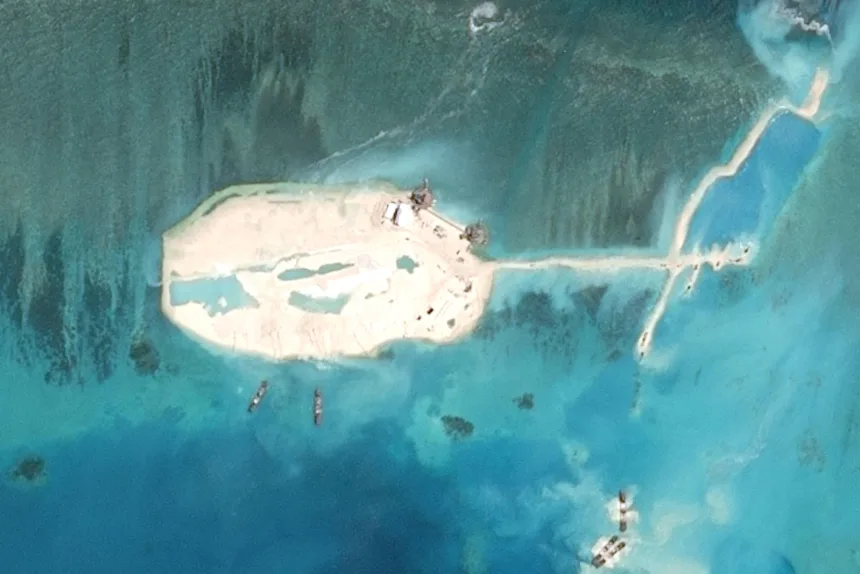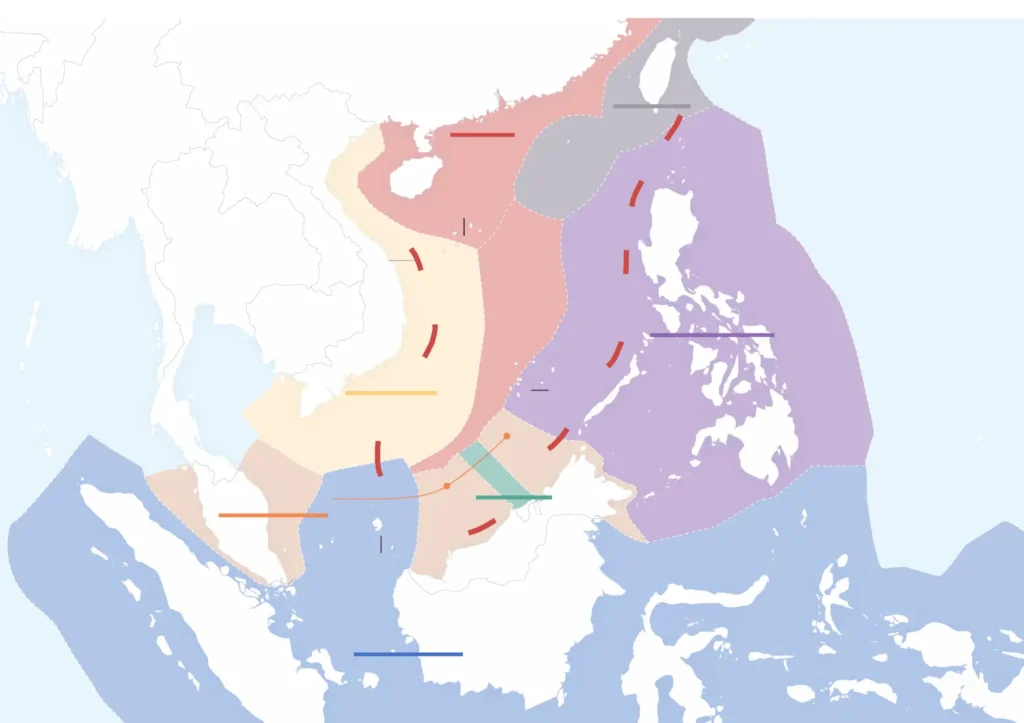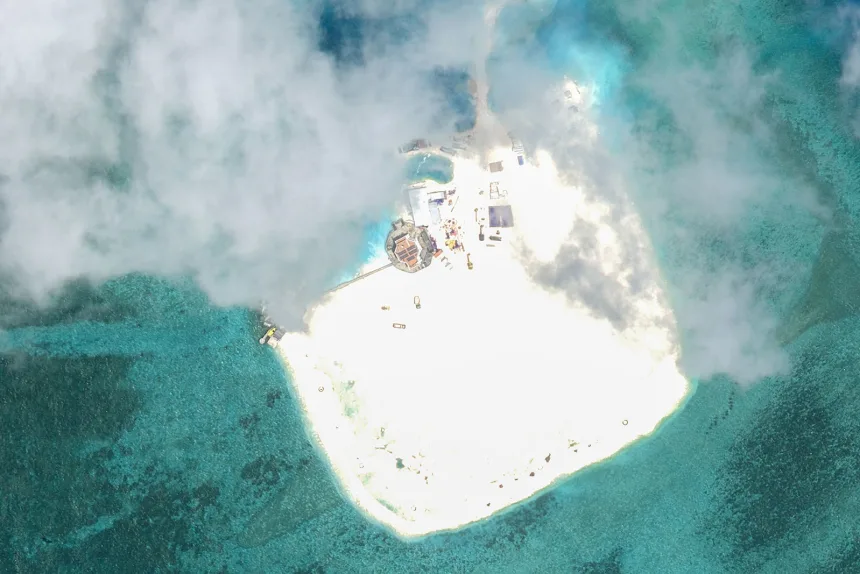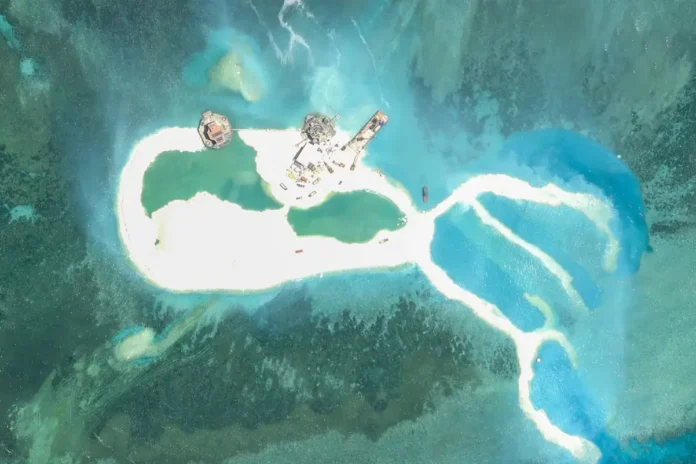[Reading level: C1 – Advanced]
Vietnam is on a South China Sea island-building binge that will likely see it soon surpass the area China has reclaimed in the strategic and contested Spratly Islands, according to a new report from the Asia Maritime Transparency Initiative.
Since the start of 2025, Hanoi has been dredging and adding surface area to eight features it controls in the island chain in the southeastern quarter of the South China Sea, said the AMTI report, based on satellite imagery from MAXAR and Planet Labs.
The Spratly Island chain consists of more than 100 small islands or reefs and is claimed in full by China, Vietnam and Taiwan with partial claims by the Philippines, Malaysia and Brunei, according to the CIA World Factbook.
China’s claims have drawn headlines for more than a decade, as Beijing has reclaimed land at several features, building runways and military installations to solidify its positions. Its building of fortifications came despite leader Xi Jinping in telling then-US President Barack Obama in 2015 that it had no plans of doing so.
Beijing claims almost all of the 1.2 million-square-mile South China Sea, through which trillions of dollars in global trade passes annually, as its sovereign territory. It bases that claim on its so-called Nine Dash Line, which the Permanent Court of Arbitration in the Hague has previously ruled has no legal basis.
Vietnam’s claims have not been as outspoken as China’s and its previous reclamation efforts less ambitious.

Some of the reefs where island-building is now going full tilt have long been held by just small pillboxes, including Alison Reef, Collins Reef, East Reef, Landsdowne Reef and Petley Reef, according to the AMTI, which is a project of the Center for Strategic and International Studies (CSIS). New land is also being constructed at three features that were built up in earlier rounds of reclamation – Amboyna Cay, Grierson Reef and West Reef – the AMTI report said.
“All 21 Vietnamese-occupied rocks and low-tide elevations in the Spratly Islands have now been expanded to include artificial land,” AMTI said.
“As of March 2025, Vietnam had created about 70 percent as much artificial land in the Spratlys as China had. Reclamation at these eight new features all but ensures that Vietnam will match—and likely surpass—the scale of Beijing’s island-building,” the report said.
Those 21 features under Hanoi’s control compare to just seven under Beijing’s, according to AMTI.
Meanwhile, on seven other Vietnamese-controlled islands where reclamation work has largely been completed, military-related structures, including munitions depots, have been or are being built, according to the report.
Sovereignty in the South China Sea is highly contested
The 1.3 million-square-mile South China Sea and the islands within it are subject to a range of claims from governments around the region. China claims almost all of it as its sovereign territory enclosed within its “nine-dash line,” but others maintain claims based on their exclusive economic zones, which extend 200 nautical miles from their shores. Key disputed spots include the Paracel Islands and Spratly Islands, both locations where China has built military installations on disputed islands.

Tensions, clashes
The new report comes amid a spike in tensions between China and the Philippines over South China Sea territory.
Competing claims by Beijing and Manila have become increasingly contentious in the past few years, including violent clashes between their coast guards with water cannons and, in one case, bladed weapons. That clash in the Spratlys near Second Thomas Shoal, on which Philippine marines are stationed in a rusting World War II naval vessel, left a Filipino crewman missing a thumb.
Last month, north of the Spratlys near Scarborough Shoal, a Chinese navy destroyer collided with a China Coast Guard ship as the two harassed a Philippine Coast Guard vessel in contested waters. Images showed heavy damage to the bow of the China Coast Guard ship.
The China-Philippines flare-ups may have provided Vietnam with excellent cover for its move to build up the islands it controls, analysts said.
“For now much of China’s bandwidth of attention is directed at the Philippines, and it would rather maintain a stable front with each of the other Southeast Asian rivals in the South China Sea,” said Collin Koh, a research fellow at the S. Rajaratnam School of International Studies (RSIS) in Singapore.
Ray Powell, director of SeaLight, a maritime transparency project at Stanford University’s Gordian Knot Center for National Security Innovation, echoed Koh’s comments.
“It seems that Beijing has calculated that keeping the Philippines isolated from the other South China Sea claimants is worth more right now than preventing Vietnam from making substantial territorial gains,” Powell said.
“Hanoi may owe Manila a debt of gratitude, since it’s hard to see how this could have happened if Beijing hadn’t been so preoccupied with the problem to the east,” Powell said, adding that, “China has been remarkably muted about Vietnam’s island-building campaign.”
“The Spratly Islands are China’s inherent territory. China firmly opposes relevant countries’ construction activities on illegally occupied islands and reefs. China will take necessary measures to safeguard its territorial sovereignty and maritime rights and interests,” Foreign Ministry spokesperson Guo Jiakun told a regular press briefing Monday.
Vietnam and the Philippines did not comment on the AMTI report when asked by CNN.
Past disagreements between China and Vietnam over South China Sea territory have resulted in bloodshed, including in 1974 when a South Vietnamese naval vessel was sunk and 53 South Vietnamese troops killed in a battle with Chinese forces over the Paracel Island chain in the northwestern part of the South China Sea.
Beijing has maintained a big edge in the South China Sea since, and Koh said it may not find Hanoi’s latest moves to be overly threatening.

“China commands a yawning gap in mobile military and coast guard assets – hence this probably explains why Beijing is not deemed to be alarmed enough to do anything to stop Hanoi,” he said.
But he cautioned Beijing must not overestimate that advantage, noting that Vietnam and the Philippines enjoy improving relations.
“There’s been effort between Vietnam and the Philippines to come closer on maritime security cooperation, as evidenced by the recent bilateral coast guard exchanges and joint exercise. That should serve as a timely reminder to Beijing that Hanoi owns the Manila card of leverage,” Koh said.
Source: https://edition.cnn.com/2025/08/28/asia/vietnam-south-china-sea-islands-intl-hnk?Date=20250829&Profile=CNN,CNN+International&utm_content=1756446170&utm_medium=social&utm_source=facebook&fbclid=IwY2xjawMeQwxleHRuA2FlbQIxMABicmlkETFjTDhYZHhVSzlXNjdnRWp0AR5IZGPgAloqyxckuYxvrf4eBWZt9SfWxbP89XQlM97vozKRUtEOq-4KFYfW_w_aem_JpmZ_mhilLfoX9zBOrBfBA
WORD BANK:
binge /bɪndʒ/ (n, v): ăn/uống/xem quá độ, quá mức
surpass /sɚˈpæs/ [C1] (v): vượt qua, trội hơn
reclaimed land /rɪˈkleɪmd lænd/ (n): đất bồi đắp
strategic /strəˈtiː.dʒɪk/ [C1] (adj): có tính chiến lược
contested /kənˈtes.tɪd/ (adj): gây tranh cãi, tranh chấp
Spratly Islands /ˈspræt.li ˈaɪ.ləndz/ (n): Quần đảo Trường Sa
transparency /trænsˈper.ən.si/ [C2] (n): tính minh bạch
initiative /ɪˈnɪʃ.ə.t̬ɪv/ [C1] (n): sáng kiến
dredge /dredʒ/ (v): nạo vét
feature /ˈfiː.tʃɚ/ (n): thực thể, đặc điểm
satellite imagery /ˈsæt̬.əl.aɪt ˈɪm.ɪ.dʒɚ.i/ (n): ảnh vệ tinh
reef /riːf/ (n): rạn san hô
partial /ˈpɑːr.ʃəl/ [C1] (adj): một phần
draw headlines /drɑː hed.laɪnz/ (v): thu hút sự chú ý của truyền thông
solidify sth /səˈlɪd.ə.faɪ/ (v): củng cố cái gì đó
fortification /ˌfɔːr.t̬ə.fəˈkeɪ.ʃən/ (n): công sự, pháo đài
sovereign /ˈsɑːv.rən/ (adj): có chủ quyền
territory /ˈter.ə.tɔːr.i/ (n): lãnh thổ
permanent /ˈpɝː.mə.nənt/ [B2] (adj): lâu dài, vĩnh viễn
court /kɔːrt/ (n): tòa án
arbitration /ˌɑːr.bəˈtreɪ.ʃən/ (n): sự phân xử, trọng tài
rule /ruːl/ (v): phán quyết
legal basis /ˈliː.ɡəl ˈbeɪ.sɪs/ (n): cơ sở pháp lý
outspoken /ˌaʊtˈspoʊ.kən/ [C2] (adj): thẳng thắn
reclamation /ˌrek.ləˈmeɪ.ʃən/ (n): sự bồi đắp, khai hoang
full tilt /fʊl tɪlt/ (adv, expression): hết tốc lực
pillbox /ˈpɪl.bɑːks/ (n): lô cốt
round /raʊnd/ (n): đợt, vòng
low-tide elevation /loʊ taɪd ˌel.əˈveɪ.ʃən/ (n): bãi triều thấp
artificial /ˌɑːr.t̬əˈfɪʃ.əl/ [B2] (adj): nhân tạo
all but ensure that /ɔːl bət ɪnˈʃʊr ðæt/ (expression): gần như đảm bảo rằng
munition /mjuːˈnɪʃ.ən/ (n): đạn dược
depot /ˈdep.oʊ/ (n): kho chứa
subject to sth /ˈsʌb.dʒɪkt tuː/ (adj): chịu/đang bị ảnh hưởng bởi
enclose sth /ɪnˈkloʊz/ (v): bao quanh cái gì
exclusive economic zone /ɪkˈskluː.sɪv ˌek.əˈnɑː.mɪk zoʊn/ (n): vùng đặc quyền kinh tế
nautical mile /ˈnɑː.t̬ɪ.kəl maɪl/ (n): hải lý
disputed /dɪˈspjuː.t̬ɪd/ (adj): tranh chấp
amid sth /əˈmɪd/ (prep): trong bối cảnh, giữa
spike /spaɪk/ (n): sự/mức tăng mạnh
contentious /kənˈten.ʃəs/ [C2] (adj): gây tranh cãi
clash /klæʃ/ (n): vụ đụng độ, xung đột
water cannon /ˈwɑː.t̬ɚ ˌkæn.ən/ (n): vòi rồng
bladed /ˈbleɪ.dɪd/ (adj): có lưỡi (dao, kiếm, cánh quạt)
marine /məˈriːn/ (n): lính thủy
station /ˈsteɪ.ʃən/ (v): đóng quân
rust /rʌst/ (n): gỉ sét
thumb /θʌm/ (n): ngón tay cái
destroyer /dɪˈstrɔɪ.ɚ/ (n): tàu khu trục
harass /həˈræs/ [C1] (v): quấy rối, quấy nhiễu
waters /ˈwɑː.t̬ɚz/ (n): vùng biển, vùng nước
bow /baʊ/ (n): mũi tàu
flare-up /ˈfler.ʌp/ (n): sự bùng phát, xung đột
cover /ˈkʌv.ɚ/ (n): tấm bình phong, sự che chắn
bandwidth of sth /ˈbænd.wɪtθ əv/ (n): băng thông, phạm vi (nghĩa bóng: năng lực xử lý)
echo sb /ˈek.oʊ/ (v): đồng tình, lặp lại ý của ai đó
isolated /ˈaɪ.sə.leɪ.t̬ɪd/ [C1] (adj): cô lập, biệt lập
claimant /ˈkleɪ.mənt/ (n): bên tranh chấp, nguyên đơn
substantial /səbˈstæn.ʃəl/ [B2] (adj): lớn, đáng kể
owe sb a debt of gratitude /ˈɡræt̬.ə.tuːd/ (expression): mang ơn ai đó
preoccupied with sth /priːˈɑː.kjə.paɪd wɪð/ (adj): bận tâm, lo nghĩ nhiều về cái gì
mute /mjuːt/ (adj): im lặng
inherent /ɪnˈhɪr.ənt/ [C2] (adj): vốn có, cố hữu
firmly /ˈfɝːm.li/ (adv): kiên quyết, vững chắc
oppose sth /əˈpoʊz/ [B2] (v): phản đối điều gì
press briefing /pres ˈbriː.fɪŋ/ (n): buổi họp báo
bloodshed /ˈblʌd.ʃed/ (n): sự đổ máu
edge /edʒ/ (n): lợi thế, ưu thế
a yawning gap (n): một khoảng cách lớn
deem /diːm/ [C2] (v): cho rằng, coi là
caution sb to/not to do sth /ˈkɑː.ʃən/ (v): cảnh báo ai nên/không nên làm gì
overestimate /ˌoʊ.vɚˈes.tə.meɪt/ (v): đánh giá quá cao
evidence /ˈev.ə.dəns/ (v): chứng minh, làm rõ bằng chứng
bilateral /ˌbaɪˈlæt̬.ɚ.əl/ (adj): song phương
joint exercise /dʒɔɪnt ˈek.sɚ.saɪz/ (n): cuộc tập trận chung
card /kɑːrd/ (n): lá bài
leverage /ˈlev.ɚ.ɪdʒ/ (n, v): đòn bẩy; tận dụng
ỦNG HỘ READ TO LEAD!
Chào bạn! Có thể bạn chưa biết, Read to Lead là một trang giáo dục phi lợi nhuận với mục đích góp phần phát triển cộng đồng người học tiếng Anh tại Việt Nam. Chúng tôi không yêu cầu người đọc phải trả bất kỳ chi phí nào để sử dụng các sản phẩm của mình để mọi người đều có cơ hội học tập tốt hơn. Tuy nhiên, nếu bạn có thể, chúng tôi mong nhận được sự hỗ trợ tài chính từ bạn để duy trì hoạt động của trang và phát triển các sản phẩm mới.
Bạn có thể ủng hộ chúng tôi qua 1 trong 2 cách dưới đây.
– Cách 1: Chuyển tiền qua tài khoản Momo.
Số điện thoại 0947.886.865 (Chủ tài khoản: Nguyễn Tiến Trung)
Nội dung chuyển tiền: Ủng hộ Read to Lead
hoặc
– Cách 2: Chuyển tiền qua tài khoản ngân hàng.
Ngân hàng VIB chi nhánh Hải Phòng
Số tài khoản: 012704060048394 (Chủ tài khoản: Nguyễn Tiến Trung)
Nội dung chuyển tiền: Ủng hộ Read to Lead
Lớp luyện thi IELTS online
Bạn đang có nhu cầu thi chứng chỉ IELTS cho đầu vào đại học, đi du học, xin việc hay xin cư trú và đang phân vân chưa biết học ở đâu?
Nếu bạn đang tìm kiếm dịch vụ luyện thi IELTS online với giáo viên uy tín và chất lượng, cũng như học phí phải chăng, thì thầy Trung và Cô Thủy (Admin và dịch giả chính của Read to Lead) có thể là một lựa chọn phù hợp dành cho bạn.
Hãy liên hệ (nhắn tin) tới trang Facebook cá nhân của mình (https://www.facebook.com/nguyen.trung.509) để tìm hiểu về lớp học và được tư vấn cũng như được học thử nha!





